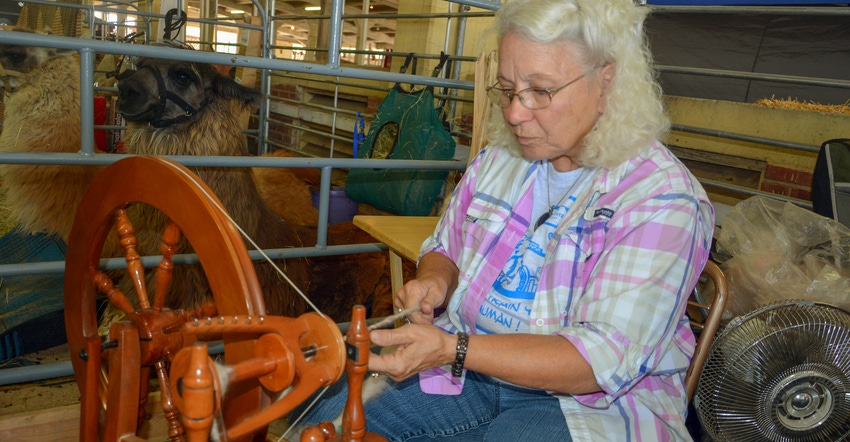
Betty Holman was set up in an out-of-the-way nook at the very end of the livestock strip at the Kansas State Fair, where the big sign said “dairy barn” but the temporary one said “llamas.”
She displayed a bunch of products she has made from the wool of Armand and Sabor, the two llamas she had on display, or from one of the six other llamas on her Oklahoma farm.
She said she discovered the value of llamas to livestock operators when her dad used “guard llamas” to protect his cattle herd from predators, but her much smaller, retirement operation involves raising the animals for a hobby to harvest their wool and create products for her own enjoyment or to give to relatives and friends.
Holman, who lives in Turpin, Okla., said her home is “straight south” of Liberal, Kan. She said llamas are gentle creatures overall and easy to work with. But, she said, they are herd animals and like to be around other llamas. Owners have to make an effort not to treat them like pets.
“You can’t baby them and talk to them, especially when they are young, or you risk having them develop a one-on-one bond as though you are one of the herd. If you make that mistake, they will treat you like they would treat another llama and that means you get spit at. A lot.”
She said she has not had that problem with her llamas.
“I only see them spit at me if I push them beyond the limit of their patience. My younger one doesn’t especially like being groomed, and if I keep at it too long, he’ll be pushed beyond what he can take, and then he will spit. That lets me know it’s time to leave him alone.”
She described the process she uses to create yarn or fabric for her crafts.
She shears her llamas to harvest the prime wool that grows on the neck and shoulders, around the barrel and down the hips. Then she cleans the fibers by picking out any discernable trash and washing it by submerging it in cool water repeatedly.
“The wool floats so you just have to push it under the water two or three times and the dirt floats to the surface,” she said. “Once you have it washed, you can lay it out on sweater screens to dry.”
When the wool is dry, it is carded by taking tufts of wool and running them through carding wheels that pull the wool through in strips that are in alignment.
 REMOVING A BATT: Betty Holman removes a batt of llama wool from her carding wheel. She said she cards the wool to remove pieces of trash and to make sure all the fibers run in the same direction. Washing and drying after carding leave the wool ready to work with.
REMOVING A BATT: Betty Holman removes a batt of llama wool from her carding wheel. She said she cards the wool to remove pieces of trash and to make sure all the fibers run in the same direction. Washing and drying after carding leave the wool ready to work with.

“The widest wheel produces a batt that is a foot or so wide,” she said. “The smaller strips are rovings that can be spun into yarn.”
Carding separates trash from the wool fibers and repeated passes through the carding wheel cleans and fluffs the wool, she said.
She learned about harvesting llama wool and using it for fabrics in a class for senior citizens at a Colorado venue.
“I met a fabulous felter, spinner and weaver, and she taught me to make hats. I have been making hats ever since,” she said.
 FELT HATS: Betty Holman creates llama wool hats using a process called “felting” where tufts of wool are laid out in alternating directions and soaked in warm, soapy water. The resulting fabric can then be formed into the shape of a hat.
FELT HATS: Betty Holman creates llama wool hats using a process called “felting” where tufts of wool are laid out in alternating directions and soaked in warm, soapy water. The resulting fabric can then be formed into the shape of a hat.

She said that spinning yarn is best when done “over and over again,” and the spinner learns how to feed and twist the fiber for maximum effect in producing yarn.
Holman, who displayed her skills at shearing, spinning and crocheting at the Kansas State Fair, said she is not raising llamas or using her talents with wool to make money.
“This is my hobby,” she said. “I started this as something to do, not as a profit thing.”
For potential llama growers, she said the animals are ruminants, which thrive on pasture and hay. They can be raised on small acreages and do well in small pastures if fed a ration of prairie hay, protein pellets and rolled oats with some cracked corn during the coldest winter months.
About the Author(s)
You May Also Like




